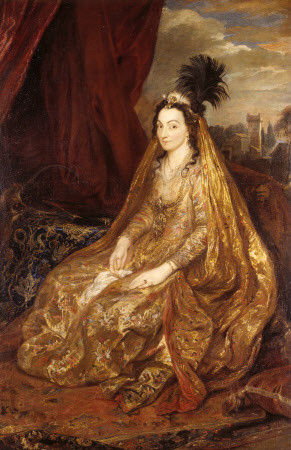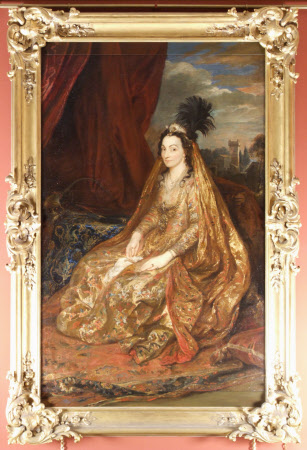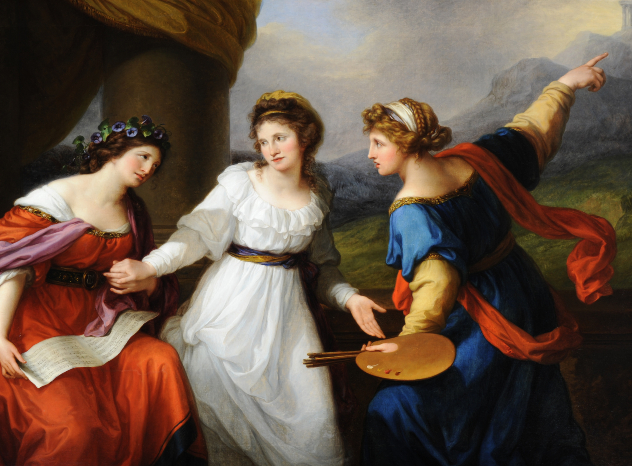Teresa, or Teresia Sampsonia, Lady Shirley (1589–1668)
Sir Anthony Van Dyck (Antwerp 1599 - London 1641)
Category
Art / Oil paintings
Date
1622
Materials
Oil on canvas
Measurements
2140 x 1290 mm
Place of origin
Rome
Order this imageCollection
Petworth House and Park, West Sussex
NT 486170
Caption
This fascinating portrait, one of a pair depicting the Englishman Sir Robert Shirley (1581–1628) and his wife Lady Teresia Sampsonia (c.1589–1668) dressed in Persian clothes, was painted in Rome in 1622. Robert Shirley was an adventurer, who from 1608 served as ambassador to the Persian shah Abbas the Great (1571–1629) and adopted Persian customs. Teresia Shirley was Circassian (people from the north-east shore of the Black Sea in Russia) and is shown seated demurely against a view of Rome. The painter, Sir Anthony van Dyck (1599–1641), may have been attracted to painting these sitters partly as a result of the stunning visual effect of their lavish clothes. Van Dyck was perhaps the most highly acclaimed and influential artist in the 17th century. He excelled at portraiture and narrative scenes, and the style he created went on to be admired and emulated for centuries. It is not known whether these portraits were a commission from the sitters, or when they came into the collections at Petworth, but they were hanging at the house by 1775 and can still be seen there.
Summary
Oil painting on canvas, Teresa, or Teresia Sampsonia, Lady Shirley [Sherley] (1589–1668) by Sir Anthony van Dyck (Antwerp 1599 – London 1641), 1622. A full-length portrait of an extravagantly dressed noblewoman, seated on a divan, three-quarters left, with both her hands in her lap, holding a handkerchief in her right hand. On her head is a tiara with a large feather. She wears a gold dress, embroidered with blue and red with a cinnamon mantle. The divan is on a red Persian carpet with red pillow in the corner. In the right background is a landscape with a square tower and a red curtain at left background. At left a monkey perched upon a table, its long thin tail arched over a vibrant blue cloth with gold decoration. Paired with NT 486169, a portrait by van Dyck of Sir Robert Shirley (1581–1628).
Full description
Teresa, or Teresia, Sampsonia was a noblewoman of the Safavid Empire of Iran during the reign of Shah Abbas I (1571–1629). Her father is understood to be a Circassian ruler named Isma'il Khan. Teresa was baptised Roman Catholic in 1608 after which she married Robert Shirley (c.1581–1628), diplomat to the Persian Shah Abbas. Together they made two extended voyages across Europe. In 1611 they travelled to England where Teresa gave birth to their son, Henry. In 1613 they returned to Isfahan on an East India Company ship. The Shirleys continued to travel over the next decade to India, Portugal, Spain and Italy. They went to Rome in 1622, and this picture and the pendant portrait of Robert (NT 486169) can be dated to Van Dyck's first visit to the city. Numerous sketches of the couple appear in Van Dyck’s Italian Sketchbooks (British Museum, 1957,1214.207.62 and 1957,1214.207.60). The sketches, made in pen and brown ink, were used by Van Dyck to prepare the later, painted portraits. The sketch of Teresa is inscribed ‘habito et maniera di Persia’.The sketch appears to be a study for her portrait, as its landscape setting is also included. Despite the artist’s annotation, Teresa’s dress is not Persian but European – there is a stomacher on the gown – and the fabric itself may be Ottoman (Hearne, Van Dyke and Britain 2009). She does, however, sit on a Persian rug. Van Dyck’s training with Rubens had sharpened his eye for the enriching effect offered by sumptuous garments such as those worn by Lady Shirley. Van Dyck had also recently begun to absorb the lessons of Titian and the other great Venetian colourists. Teresa was a gifted linguist and spoke more than half a dozen languages. Historian Bernadette Andrea recounts how she saved her husband’s life on at least two occasions: ‘once as they set off on their first journey when his Persian enemies sought to kill him, which earned her the accolade "a true Amazon" and again when the couple encountered hostile Portuguese traders on their way to Goa.’ (See the entry for 'Lady Teresa Sampsonia Sherley' in the Oxford Dictionary of National Biography). After Robert’s death, Teresa was accused of the capital crime of apostasy and her property was confiscated. She became a fugitive, hiding in an Augustinian church in Isfahan and an Armenian convent just outside the Safavid capital. She received a special permit to travel, went to Istanbul for three years and then on to Rome where she settled and remained for more than three decades until her death in 1668. It is not known exactly when this portrait and its pendant of Robert Shirley arrived at Petworth. It seems likely that they were purchased by the 2nd Earl of Egremont (1710–63) and are first listed at Petworth in 1764.
Provenance
Neither this painting, nor its companion of Sir Robert Shirley (NT 486169) appear in the inventories of 1671 and 1672 of the 10th Earl of Northumberland (1602-1668). It was in the collection of the 2nd Earl of Egremont (1710–63) by the time of his death in 1763; by descent, until the death in 1952 of the 3rd Lord Leconfield, who had given Petworth to the National Trust in 1947, and whose nephew and heir, John Wyndham, 6th Lord Leconfield and 1st Lord Egremont (1920–72) arranged for the acceptance of the major portion of the collections at Petworth in lieu of death duties (the first ever such arrangement) in 1956 by HM Treasury.
Credit line
Petworth House, The Egremont Collection (acquired in lieu of tax by HM Treasury in 1956 and subsequently transferred to the National Trust)
Makers and roles
Sir Anthony Van Dyck (Antwerp 1599 - London 1641), artist
Exhibition history
The World in Rome. Art and Globalization in the Baroque Age, Scuderie del Quirinale, Rome, 2025
References
Bellori 1672: G.P.Bellori, Le Vite de’Pittori, Scultori, et Architetti Moderni, Rome, 1672 Cust 1900: L. Cust. Anthony van Dyck, 1900, pp.3 6 and 243, nos.117 and 119. (Treasures from Country Houses of the National Trust and the National Trust for Scotland) Trésors des Châteaux Britanniques (exh cat) Palais des Beaux Arts, Brussels, 28 September -18 November 1973 Millar 1982: Oliver Millar, Van Dyck in England, exh.cat. National Portrait Gallery, London 1982-3, pp. 52-5, nos. 9 and 10. Sir Anthony Van Dyck, National Gallery of Art Washington, 1990-91, nos. 28 and 29. Laing 2000: Alastair Laing, In Trust for the Nation: Paintings from National Trust Houses (exh. cat.), The National Gallery, London, 22 November 1995 - 10 March 1996 Barnes, Millar, de Poorter, Vey 2004: Susan J. Barnes, Oliver Millar, Nora de Poorter, Horst Vey, Van Dyck: A Complete Catalogue of the Paintings, New Haven and London, 2004, pp. 203-5, nos. II.62 and II.63. Van Dyck & Britain, Tate Britain, London 18th February - 17th May 2009 Andrea 2019: Bernadette Andrea, ‘Sherley, Lady Teresa Sampsonia’, Oxford Dictionary of National Biography, published online, 9 May 2019. Andrea 2019: Bernadette Andrea, 'The Global Travels of Teresa Sampsonia Sherley's Carmelite Relic' in Akhimie and Andrea Eds., Travel & Travail: Early Modern Women, English Drama and The Wider World, University of Nebraska Press: 2019. Cappelletti and Freddolini 2025: Francesca Cappelletti and Francesco Freddolini, Global Baroque, The World in Rome in the Age of Bernini, exh.cat. Scuderie del Quirinale, Rome, 2025, pp. 16-18, 326-31, no. 85.


